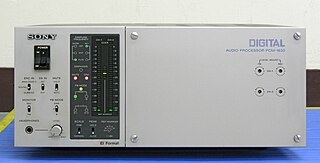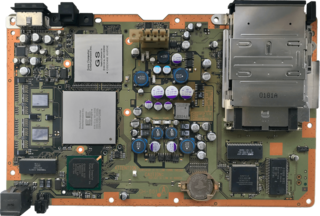Related Research Articles

MPEG-2 is a standard for "the generic coding of moving pictures and associated audio information". It describes a combination of lossy video compression and lossy audio data compression methods, which permit storage and transmission of movies using currently available storage media and transmission bandwidth. While MPEG-2 is not as efficient as newer standards such as H.264/AVC and H.265/HEVC, backwards compatibility with existing hardware and software means it is still widely used, for example in over-the-air digital television broadcasting and in the DVD-Video standard.

The National Television System Committee (NTSC) developed the analog television color system that was introduced in North America in 1954 and stayed in use until digital conversion. It is one of three major analog color television standards, the others being PAL and SECAM. All the countries using NTSC are currently in the process of conversion, or have already converted to the ATSC standard, or to DVB, ISDB or DTMB.
Frame rate is the frequency (rate) at which consecutive images (frames) are captured or displayed. The term applies equally to film and video cameras, computer graphics, and motion capture systems. Frame rate may also be called the frame frequency, and be expressed in hertz. Frame rate in electronic camera specifications may refer to the maximal possible rate, where, in practice, other settings may reduce the frequency to a lower number.

Compact Disc Digital Audio, also known as Digital Audio Compact Disc or simply as Audio CD, is the standard format for audio compact discs. The standard is defined in the Red Book, one of a series of Rainbow Books that contain the technical specifications for all CD formats.

DV refers to a family of codecs and tape formats used for storing digital video, launched in 1995 by a consortium of video camera manufacturers led by Sony and Panasonic. In the late 1990s and early 2000s, DV was strongly associated with the transition from analog to digital desktop video production, and also with several enduring "prosumer" camera designs such as the Sony VX-1000. DV is sometimes referred to as MiniDV, which was the most popular tape format using a DV codec during this time.
Speex is an audio compression codec specifically tuned for the reproduction of human speech and also a free software speech codec that may be used on VoIP applications and podcasts. It is based on the CELP speech coding algorithm. Speex claims to be free of any patent restrictions and is licensed under the revised (3-clause) BSD license. It may be used with the Ogg container format or directly transmitted over UDP/RTP. It may also be used with the FLV container format.

Colorburst is an analog video, composite video signal generated by a video-signal generator used to keep the chrominance subcarrier synchronized in a color television signal. By synchronizing an oscillator with the colorburst at the back porch (beginning) of each scan line, a television receiver is able to restore the suppressed carrier of the chrominance (color) signals, and in turn decode the color information. The most common use of colorburst is to genlock equipment together as a common reference with a vision mixer in a television studio using a multi-camera setup.
SMPTE timecode is a set of cooperating standards to label individual frames of video or film with a timecode. The system is defined by the Society of Motion Picture and Television Engineers in the SMPTE 12M specification. SMPTE revised the standard in 2008, turning it into a two-part document: SMPTE 12M-1 and SMPTE 12M-2, including new explanations and clarifications.
AES3 is a standard for the exchange of digital audio signals between professional audio devices. An AES3 signal can carry two channels of PCM audio over several transmission media including balanced lines, unbalanced lines, and optical fiber.

In signal processing, sampling is the reduction of a continuous-time signal to a discrete-time signal. A common example is the conversion of a sound wave to a sequence of samples.
In video technology, 24p refers to a video format that operates at 24 frames per second frame rate with progressive scanning. Originally, 24p was used in the non-linear editing of film-originated material. Today, 24p formats are being increasingly used for aesthetic reasons in image acquisition, delivering film-like motion characteristics. Some vendors advertise 24p products as a cheaper alternative to film acquisition.
High-definition video is video of higher resolution and quality than standard-definition. While there is no standardized meaning for high-definition, generally any video image with considerably more than 480 vertical scan lines or 576 vertical lines (Europe) is considered high-definition. 480 scan lines is generally the minimum even though the majority of systems greatly exceed that. Images of standard resolution captured at rates faster than normal, by a high-speed camera may be considered high-definition in some contexts. Some television series shot on high-definition video are made to look as if they have been shot on film, a technique which is often known as filmizing.

A PCM adaptor is a device that encodes digital audio as video for recording on a videocassette recorder. The adapter also has the ability to decode a video signal back to digital audio for playback. This digital audio system was used for mastering early compact discs.
This article discusses moving image capture, transmission and presentation from today's technical and creative points of view; concentrating on aspects of frame rates.

In digital audio using pulse-code modulation (PCM), bit depth is the number of bits of information in each sample, and it directly corresponds to the resolution of each sample. Examples of bit depth include Compact Disc Digital Audio, which uses 16 bits per sample, and DVD-Audio and Blu-ray Disc which can support up to 24 bits per sample.
High-definition television describes a television system providing a substantially higher image resolution than the previous generation of technologies. The term has been used since 1936, but in modern times refers to the generation following standard-definition television (SDTV), often abbreviated to HDTV or HD-TV. It is the current de facto standard video format used in most broadcasts: terrestrial broadcast television, cable television, satellite television and Blu-ray Discs.

Chick flick is a slang term, sometimes used pejoratively, for the film genre catered specifically to women's interests, and is marketed towards women demographics. They generally tend to appeal more to a younger female audience and deals mainly with love and romance. Although many types of films may be directed towards a female audience, the term "chick flick" is typically used only in reference to films that contain personal drama and emotion or themes that are relationship-based. Chick flicks often are released en masse around Valentine's Day. Feminists such as Gloria Steinem have objected to terms such as "chick flick" and the related genre term "chick lit", and a film critic has called it derogatory.
In digital audio, 44,100 Hz is a common sampling frequency. Analog audio is often recorded by sampling it 44,100 times per second, and then these samples are used to reconstruct the audio signal when playing it back.

The PlayStation 2 technical specifications describe the various components of the PlayStation 2 (PS2) video game console.
References
- ↑ "OculusVR/Flicks". GitHub. Retrieved 21 October 2018.
- 1 2 "Facebook invents new unit of time". 21 October 2018. Retrieved 21 October 2018– via www.bbc.co.uk.
- ↑ Raphaël Troncy, Jean Carrive, Steffen Lalande and Jean-Philippe Poli (2004). "A Motivating Scenario for Designing an Extensible Audio-Visual Description Language".Cite journal requires
|journal=(help)CS1 maint: multiple names: authors list (link)
